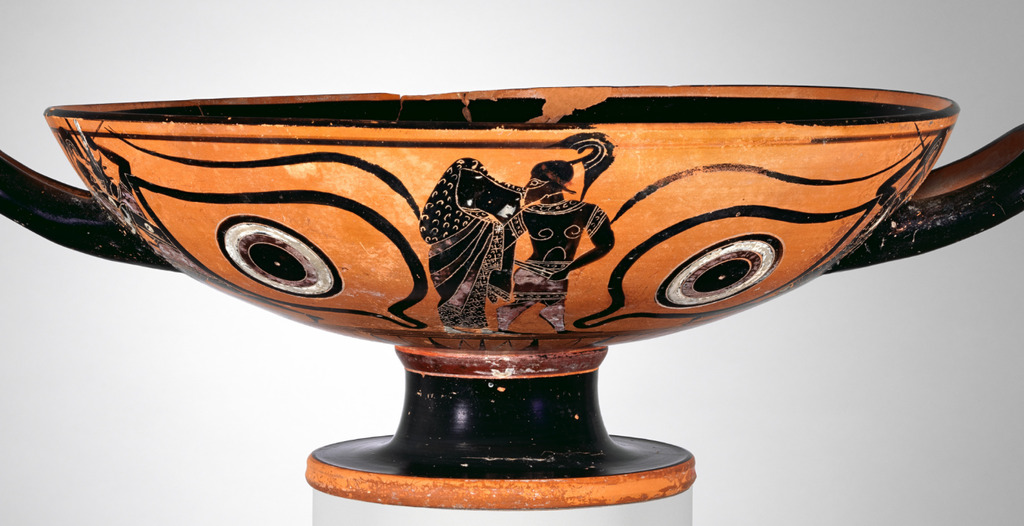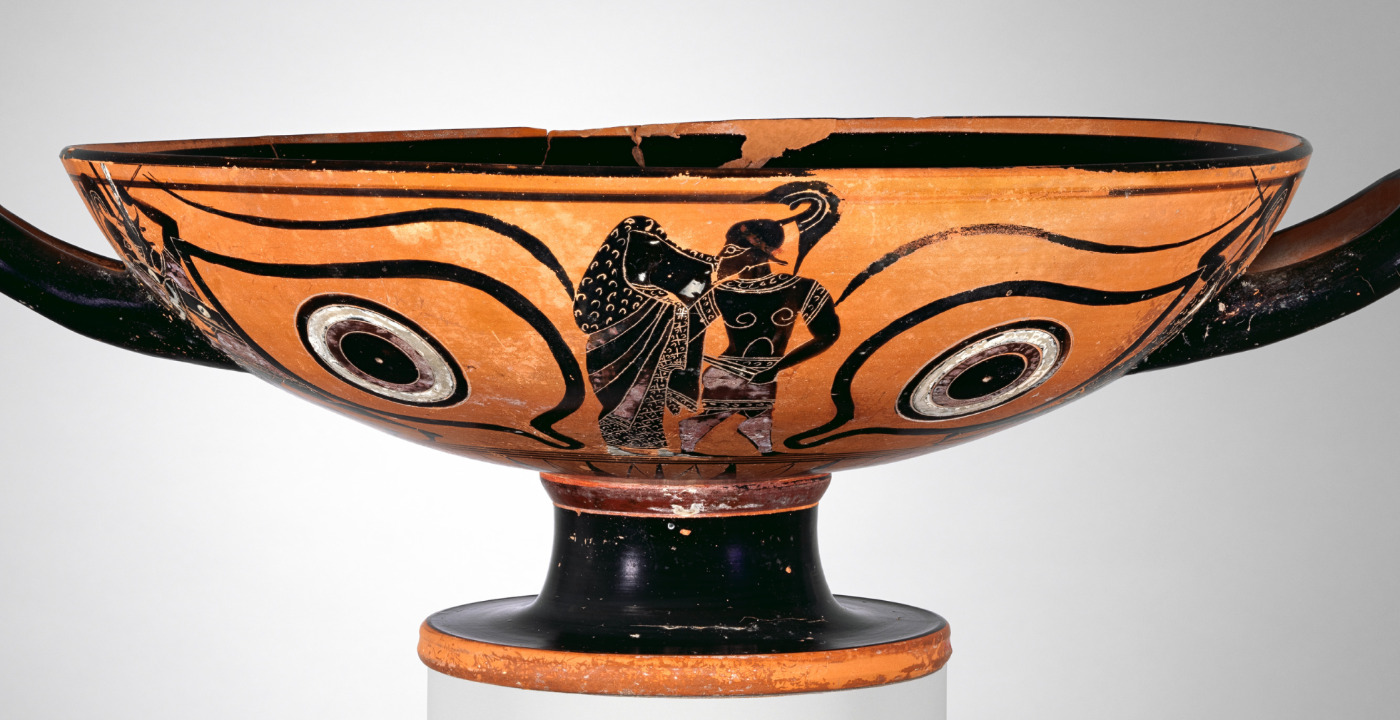Birth
Taras: second half of the sixth century BCE. Taras was a Spartan colony in Magna Graecia (southern Italy); now Taranto.
Death
Taras: late sixth century BCE. Melōsa’s precise dates of birth and death are uncertain. The dates given are determined by the date of her cup and the inscription on it.
Melōsa was a young woman who won a contest in wool carding during the sixth century BCE in Taras, for which she was awarded a prestigious prize.
Greek culture has been characterized as essentially competitive, although only male-male competition is usually represented. Evidence from the Greek world that women participated in competitions against each other is rare, and noteworthy. Melōsa’s victory in a female-female contest in the textile manufacturing field adds to that evidence and shows that women could receive recognition for accomplishments in traditionally female activities.
Melōsa’s prize was an Attic kylix–a wine cup–and her victory was recorded on it in a short verse inscription. The inscription on Melōsa’s prize presents a strong case for her literacy and, therefore, forces a re-evaluation concerning literacy among women in Ancient Greece.
Personal Information
Name(s) Melōsa
Date and place of birth Taras: second half of the sixth century BCE. Taras was a Spartan colony in Magna Graecia (southern Italy); now Taranto.
Date and place of death Taras: late sixth century BCE.
Melōsa’s precise dates of birth and death are uncertain. The dates given are determined by the date of her cup and the inscription on it.
Family
Mother No information available.
Father No information available.
Marriage and Family Life
No information available.
Education (short version) Probably home schooled by her mother.
Education (longer version) There exists no specific information about her education. The education of Greek women is poorly attested; this is particularly true for women in the Archaic Period and for women outside Athens. In the absence of evidence for formal schooling, women are believed to have been largely home schooled by their mothers.
Religion Paganism. This can be assumed from the culture in which she lived.
Transformation(s)
Melōsa was a young woman who won a contest in wool carding during the sixth century BCE in Taras, for which she was awarded a prestigious prize.
As working wool was an expected skill for Greek women, her expertise is not of itself unusual. However, the existence of a competition between girls, for which there was a prize, challenges the assumption that competitions in Ancient Greece were only focused on male activities.
Greek culture has been characterized as essentially competitive, although only male-male competition is usually represented. Evidence from the Greek world that women participated in competitions against each other is rare, and noteworthy. Melōsa’s victory in a female-female contest in the textile manufacturing field adds to that evidence and shows that women could receive recognition for accomplishments in traditionally female activities.
Melōsa’s prize was an Attic kylix–a wine cup–and her victory was recorded on it in a short verse inscription. The text declares her ownership of the prize and celebrates her victory over the other competitors. The inscription was written in Melōsa’s dialect, using the script and orthography of Taras. Modern scholarship had concluded that women in Archaic and Classical Greece would not often have been literate; this conclusion has largely been drawn from a lack of sufficient evidence for female literacy, but the inscription on Melōsa’s prize presents a strong case for her literacy and, therefore, forces a re-evaluation concerning literacy among women in Ancient Greece. Her cup would unlikely contain a label and record of her achievement if she could not read it.
Moreover, the inscription is in verse, which implies a higher level of literary competence than a simple statement of ownership. While it cannot be known for sure, there is no reason to presume that Melōsa did not compose and inscribe the text herself; graffiti declaring ownership of objects is often written by the owner. If the text was written for her rather than by her, then the author would have assumed she could understand and appreciate the verse.
Contemporaneous Network(s)
The inscription on Melōsa’s cup declares that ‘she defeated the other girls.’ This attests to a social network of young women in Taras who interacted with each other within a competitive framework.
Textile production was a specialty of Taras; the Hellenistic Tarentine poet Leonidas also bestowed recognition on women for their textile work, indicating a wider community of appreciation for the skills of women. The women he names for their accomplishment in weaving are: Bittion, Antianeira and Bitiē, who worked together; he also names Platthis, for her hard work over many years (to the age of eighty). He also mentions by name two groups of sisters: Athenō, Meliteia, Phintō and Glēnis, and Autonoma, Meliteia and Boïscion, who made dedications to Athena of their wool-working tools.
That there was an event for young women as competitors is indirect evidence for other key roles: event organisers and competition judges. There is little doubt that these individuals would also have been women. There is evidence of women organizing events at the time; the festival of Hera at Olympia was run by women selected on the grounds of age, position, and reputation.
less
Significance
Works/Agency
Melōsa’s prize was inscribed with text recording her victory:
‘I am Melōsa’s victory prize; she defeated the girls in carding.’
This inscription was placed underneath the foot of the kylix, where it would have been visible when the cup was hung on the wall in the main room of a home, the usual practice when such cups were not in use. This suggests that the author of the text, who may well have been Melōsa herself, was proud of her achievement and wanted to celebrate it with visitors to her home.
Contemporaneous Identifications:
Reputation
The award, in this case an imported kylix from Athens, is evidence of public recognition for Melōsa’s achievement in carding. We have no further information about what the competition entailed nor if other wool-working, beyond the carding, was involved. Other competitions in the Greek world were held in a religious context and we know it was normal for women to create garments for deities and for young women, in particular, to be involved in such religious practices. For example, girls and young women were involved in the ceremonial weaving of a new peplos for Athena in Athens each year. The women of Sparta wove a garment for the statue of Apollo Hyakinthos, and as this god was also worshipped in the Spartan colony of Taras, a similar religious practice is highly likely. A festival where the garment for this god would have been produced is a potential context for a competition involving Melōsa and other young women of Taras.
less
Controversies
Controversy
The inscription on the kylix has instigated two avenues of discussion, both of which have been challenged recently (Plant, 2022). The first is on the social status of Melōsa. Milne (1944, 1945) raised the possibility that Melōsa was an hetaira, an escort, courtesan, or the unwed female partner of a man. The general acceptance of her as a prostitute (as Fischer, 2011) led to the second line of argument (Nafissi, 1998) that the contest she won did not involve wool-working at all; it was in fact a strip tease: she defeated the other girls in an erotic beauty contest.
Milne’s argument is based on Melōsa’s type of name. However, the evidence for female naming practices in the Greek world, particularly in the Archaic period, is not secure. To state that the name Melōsa indicates non-citizenship status goes beyond the evidence available. In fact, the compound name Astymeloisa (where -meloisa is an Aeolic dialectical variation on -melōsa) is attested in the Spartan poetry of Alkman. The prefix Asty-, which means city/citizen, and the context of the poem the name is found in define Astymeloisa as a citizen woman (astē). As the name -melōsa is used in a compound female name in Spartan poetry sung by young women, astai, in public performance, it is safe to conclude that the simple name itself would also have been known and acceptable in the Spartan community, and thus also in their colony of Taras.
Nafissi takes reference to women carding in public from the comedy of Aristophanes as evidence of the word holding an erotic connotation. Coupled with an assumption that the name Melōsa itself signifies this woman was a sex-worker, and that the prize is a wine cup of a type used by men at their drinking parties, the conclusion is drawn that the reader should not take the reference to carding at face value. This argument goes beyond what the scene in Aristophanes’ Ecclesiazusae suggests; it is true that the leader of the women does not want her fellow women to card wool in the assembly, but this is because they are pretending to be men and working wool was a marker of their gender (Eccl. 93–4). The scene does not suggest that carding wool was considered a sexually provocative act at all. Moreover, the ownership of a kylix did not define a woman as an hetaira: other wine cups have been found with the names of women owners on them, such as Eucharis’s (Louvre K 198) and Philtō’s (British Museum 1885, 1213.30), and there were no prohibitions against women drinking in the Greek world.
New and Unfolding Information and/or Interpretations
Previous studies of Melōsa’s inscription have focused on what it may reveal about her relationship with men, looking to define her and her activity through a male-female paradigm. Yet, the text of her inscription does not mention men at all. Melōsa does not define herself by any men in her life, not even her father (while identifying yourself through the patriarchal line was the common practice, other female authored texts by Sappho and Nossis show that women did not necessarily conform to this practice when writing about themselves and other women). Instead, Melōsa defines herself by her victory in competition with other young women.
Melōsa’s inscription demonstrates her personal view on the importance of her status within her peer group. In order to understand the full richness of Ancient Greek society we must recover the richness of this female past. To do this we must go beyond the narrow viewpoint in which female lives are defined by their male relationships and take account of the evidence we have that women participated in their own active social networks that created public social capital for themselves.
less
Clusters & Search Terms
Current Identification(s): Ancient History
Clusters
Ancient World: Sappho, Telesilla, Diotima, Hypatia,
Textiles: Zhu Kerou
Search Terms
Textiles, Ancient World
References in existing schemas
No information found
less
Bibliography
Sources
Primary (selected):
Attic black-figure kylix (eye-cup), dated about 540-530 BCE. Metropolitan Museum of Art, n. 44.11.1.
Archival Resources (selected):
Beck, F. A. G. 1975, An Album of Greek Education, Sydney.
Fischer, M. 2011, “Hetaira’s Kalathos: Prostitutes and the Textile Industry in Ancient Greece,” Ancient History Bulletin 25, pp. 9–28.
Milne, M. J. 1944, “Melusa's Prize,” Bulletin of the Metropolitan Museum of Art 3, pp. 110–12
Milne, M. J. 1945,‘A prize for wool-working’, American Journal of Archaeology 49, pp. 528–33
Nafissi, M. 1998, “Ξαίνειν : le gambe di Melosa (LSAG2, 283 nr. 1),” La Parola del Passato 53, pp. 30–39
Plant, I. M. 2022, “Melōsa and her Prize: The Victory of a Woman in Ancient Greece,” Gender & History, Vol.0 No.0 July 2022, pp. 1–19. https://doi/epdf/10.1111/1468-0424.12639
Web Resources (selected):
Attic Black-Figure Eye-Cup c. 540-530 bce. The Metropolitan Museum of Art, n. 44.11.1 https://www.metmuseum.org/art/collection/search/254509
Issues with the Sources
Women’s lives are not well attested in Ancient Greece and there are few women’s voices preserved. Our information about Melōsa comes from an inscription, graffiti incised on the base of an Attic black figure kylix from Taras. This cup is now in the Metropolitan Museum of Art, n. 44.11.1.



Comment
Your message was sent successfully